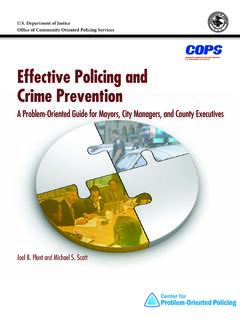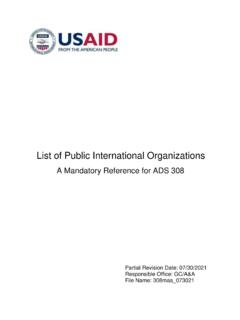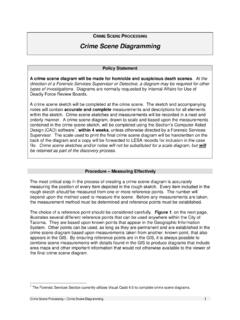Transcription of Opportunity Makes the Thief - Center for Problem-Oriented ...
1 Police Research Series Paper 98 Opportunity Makes the ThiefPractical theory for crime preventionMarcus Felson Ronald V. ClarkeEditor: Barry WebbHome OfficePolicing and Reducing crime UnitResearch, Development and Statistics Directorate50 Queen Anne s GateLondon SW1H 9 ATCrown Copyright 1998 First Published 1998 Policing and Reducing crime Unit: Police Research SeriesThe Policing and Reducing crime Unit (PRC Unit) was formed in 1998 as a resultof the merger of the Police Research Group (PRG) and the Research and StatisticsDirectorate. The PRC Unit is now one part of the Research, Development andStatistics Directorate of the Home Office. The PRC Unit carries out andcommissions research in the social and management sciences on policing andcrime reduction, broadening out the role that PRG played. The PRC Unit has now combined PRG s two main series into the Police ResearchSeries, continuing PRG s earlier work. This will present research material on crimeprevention and detection as well as police management and organisation commissioned by PRG will appear as a PRC Unit the text there may be references to PRG and these now need to beunderstood as relating to the PRC 1-84082-159-0 Copies of this publication can be available in formats accessible tothe visually impaired on request.
2 (ii)CForewordAlong with personal and social factors that are usually thought of as causes, thisreport Makes the case for seeing Opportunity as a third principal cause of the wisdom from several recent and converging Opportunity theories,this report is timely in view of the local crime and disorder strategies that will haveto be developed over the next few months. It improves our understanding of howopportunities to commit crime contribute to criminal motivation, and provides aperspective for developing workable solutions to prevent specific crime problems. S W BOYS SMITHD irector of Police PolicyHome OfficeNovember 1998 (iii)AcknowledgementsWe owe an intellectual debt of gratitude to many colleagues whose work has had amojor impact on our own. Several scholars at the Home Office, or elsewhere in Great Britain have advancedour thinking, including Derek Cornish, Paul Ekblom, Gloria Laycock, Pat Mayhew,Ken Pease, Barry Poyner, Barry Webb and Nick have also drawn from several Canadians, including Patricia Brantingham, PaulBrantingham and Maurice Cusson.
3 Americans include John Eck, HermanGoldstein, C. Ray Jeffery, George Kelling, George Rengert, David Weisburd andDiane Zahm. We have also been influenced by the work of Johannes Knutsson and EckartKuhlhorn in Sweden and Ross Homel in Australia. Many others have changed ourthinking in small ways and , we would like to thank Wes Skogan, professor at Northwestern Universityin Chicago for agreeing to referee this report. The AuthorsMarcus Felson is Professor at the Rutgers University School of Criminal Justice andhas served as professor at the University of Southern California and the Universityof Illinois. He is best known as a criminological theorist, specifically as anoriginator of routine activity theory. In recent years, he has turned his attention tocrime prevention. His most recent book is crime and Everyday Life, of which thesecond edition was published in V. Clarke is Professor and Dean at the Rutgers University School ofCriminal Justice, posts he has held for more than ten years.
4 He was previouslyHead of the Home Research and Planning Unit where he played a significant partin the development of situational crime prevention and in the launching of theBritish crime Survey. His most recent book is Situational crime Prevention:Successful Case Studies, of which the second edition was published in 1997. (iv)Executive summaryCrime theory can and should assist crime prevention. Recent Opportunity theories of crime have emphasized principles which are close to the real world, easyto explain and teach, and ready to put into practice. They include the routineactivity approach, the rational choice perspective, and crime pattern theory. Thesetheories build on the old saying that Opportunity Makes the Thief . They aredescribed in this publication, which argues that Opportunity is a root cause ofcrime, and illustrates how the theories assist thinking about crime principles of crime Opportunity theory are presented in this publication:1. Opportunities play a role in causing all crime , not just common propertycrime.
5 For example, studies of bars and pubs show how their design andmanagement plays an important role in generating violence or preventing of credit card and other frauds identify security loopholes that can beblocked. Even sexual offenses and drug dealing are subject to opportunityreduction. 2. crime opportunities are highly specific. The robbery of post offices dependsupon a different constellation of opportunities than for bank robberies or muggingson the street. Theft of cars for joyriding has an entirely different pattern ofopportunity than theft of cars for their parts, and different again from car theft forsale abroad. crime Opportunity theory helps sort out these differences, which needto be understood if prevention is to be properly tailored to the crimes in opportunities are concentrated in time and space. Dramatic differencesare found from one address to another, even within a high crime area. crime shiftsgreatly by hour of day and day of the week, reflecting the opportunities to carry itout.
6 Routine activity theory and crime pattern theory are helpful in understandingthe concentration of crime opportunities at particular places and times. 4. crime opportunities depend on everyday movements of andtheir targets shift according to the trips to work, school, and leisure settings. Forexample, pickpockets seek crowds in the city centre and burglars visit suburbs inthe afternoon when residents are at work or One crime produces opportunities for are many ways in whichthis can occur. For example, burglary tends to set up conditions for buying andselling stolen goods and for credit card fraud. Pimping and prostitution can bringassaults and robbery in their wake. A successful break-in may encourage theoffender to return at a later date. If a youth has his bike taken, he may feel justifiedin stealing another one in replacement. (v)6. Some products offer more tempting crime opportunities. These opportunitiesreflect particularly the value, inertia, visibility of, and access to potential crimetargets.
7 For example, VCRs are high in value and low in inertia (they can easily becarried), and are often left in visible and accessible locations. This helps explainwhy they are so frequently taken by burglars. 7. Social and technological changes produce new crime opportunities. Any newproduct goes through four stages: innovation, growth, mass marketing andsaturation. The middle two stages tend to produce the most theft. Thus whenlaptop computers first came on the market, they were rather exotic machinesappealing to only a few consumers. As their price declined and more people beganto understand their uses, the market for them began to grow. At the same time,they began to be at risk of theft. These risks remain high at present while they arebeing heavily promoted and are much in demand. As their price reduces further,and most people can afford them, their risks of theft will decline to levels more likethose of calculators and other everyday business aids. 8. crime can be prevented by reducing opportunities.
8 The Opportunity -reducingmethods of situational crime prevention fit systematic patterns and rules which cutacross every walk of life, even though prevention methods must be tailored to eachsituation. These methods derive from rational choice theory and aim, (i) toincrease the perceived effort of crime , (ii) to increase the perceived risks, (iii) toreduce the anticipated rewards, and (iv) to remove excuses for crime . Thussituational crime prevention is not just a collection of ad hoc methods, but is firmlygrounded in Opportunity theory. There are approaching one hundred evaluatedexamples of the successful implementation of situational crime prevention. 9. Reducing opportunities does not usually displace haveusually found little displacement following the implementation of situationalprevention. No studies have found displacement to be complete. This means thateach person or organization reducing crime can accomplish some real gain. Evencrime which is displaced can be directed away from the worst targets, times orplaces.
9 10. Focused Opportunity reduction can produce wider declines in measures in one location can lead to a diffusion of benefits to nearbytimes and places because offenders seem to overestimate the reach of the , there is good reason to believe that reductions in crime Opportunity candrive down larger crime rates for community and society.(vi)ContentsPageForeword(iii)Ack nowledgements(iv)Executive summary(v)List of boxes(viii)A. Introduction1B. The New Opportunity Theories41. The Routine Activity Approach42. crime Pattern Theory63. The Rational Choice Perspective7C. Ten Principles of Opportunity and Crime91. Opportunities play a role in causing all crime92. crime opportunities are highly specific133. crime opportunities are concentrated in time andspace144. crime opportunities depend on everyday movements of activity165. One crime produces opportunities for another176. Some products offer more tempting crime opportunities197. Social and technological changes produce new crime opportunities228.
10 crime can be prevented by reducing opportunities239. Reducing opportunities does not usually displace crime2510. Focused Opportunity reduction can produce wider declines in crime30D. Conclusions33 References34(vii)(viii)List of boxesF i g u re in temptation activity theory and the basic crime principles of Opportunity and Activity Theory and the Setup for a and Opportunity 12 can backfire to create opportunities for victimization and crime Dijk crime chains lorries get Opportunity -reducing techniques of situational crimeprevention should not be taken for laws and the Opportunity for motorcycle of benefits and CCTV in university car theory has long seemed irrelevant to those who have to deal witho ffenders in the real world. This irrelevance stems partly from attributing thecauses of crime to distant factors, such as child-rearing practices, genetic makeup,and psychological or social processes. These are mostly beyond the reach ofe v e ryday practice, and their combination is extremely complicated for those whowant to understand crime , much less do something about it.









